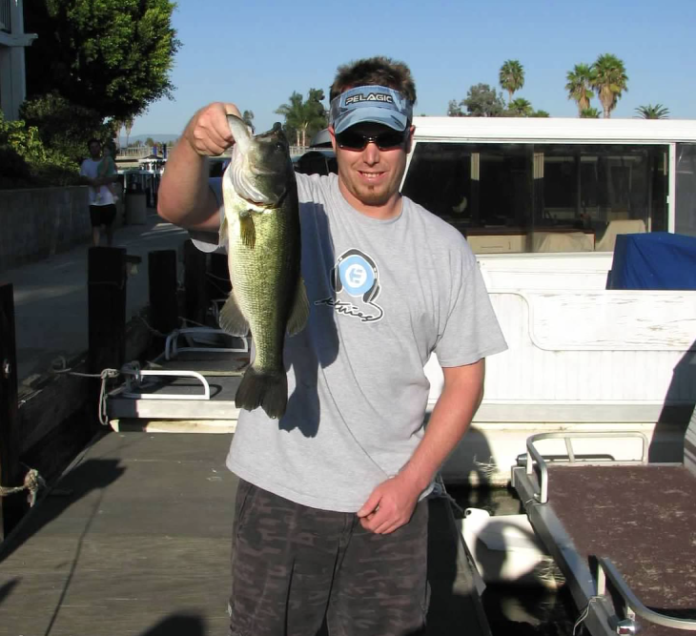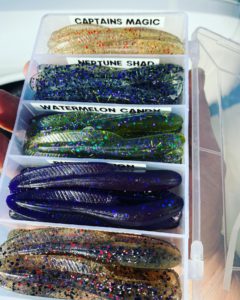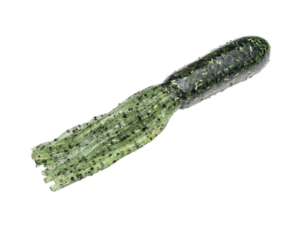
BY MIKE STEVENS
SAN MARCOS – I’m a lousy largemouth bass fisherman. There was a time in which I gave it an honest run in the mid-to-late ‘90s when I had access to daily intel and an employee discount at the tackle shop I worked at along with a buddy with one of those 2-man, plastic pedestal-seat deathtraps powered by an electric trolling motor.
Lakes Hodges and Wohlford were the primary targets among a few others, and sticking a few fish in a full day was considered a success.
My short-lived and gradual ascension as a freshwater bass angler was derailed primarily by the discoveries of “ninja fishing” the local community lake and saltwater bass. At that point, fishing all day for a limit of largies started playing third fiddle to easily getting way into double-digit numbers with much less effort on community lakes, golf course ponds and half-day boats. That being said, for the most part (not entirely) my personal growth as a freshwater basser came to a screeching halt at around age 23, and it remains at that level at 44.
However, I was in the game long enough to develop my own confidence techniques, and over the years I saw them get pushed aside for modern tactics including but not limited to stuff that’s all the rage in Japan. Now, regardless of what species I am targeting on both fresh or saltwater, I don’t give credit to the evolutionary nature of fish to believe something that worked in 1995 (or 1955 for that matter) wouldn’t work today.
The way I see it, a trout is a trout, a tuna’s gonna tuna and a bass is definitely a bass. Keeping my lousiness in mind, if it works for me, it will definitely work for you.
Split-shotting reapers
While it’s not exactly the same presentation, the arrival of drop- shot rigs can be credited/blamed for making the majority of modern bass anglers forget about split-shotting despite the fact that it was the go-to for piling up largemouth numbers. The term “reaper” became a generic term for any leech-shaped soft plastic bait, and most of the ones employed on western reservoirs were in the 2- to 4-inch range.

In my tackle shop days, I had a regular-customer was was a successful competitive bass angler on the local level, and he competed in a lot of club tournaments that paired boat owners with a back seater without a boat of his own. The tourneys were a combined-weight format, and often times the boater called the shots on what the backseater was going to do. I remember that customer of ours saying something along the lines of, “I just have them dragging reapers all day, because I know they’re to catch a lot of fish even if they don’t know what they’re doing, and hopefully he connects to some keepers.”
The rig is simple: light (usually 6- or 8-pound) line tied to a 1 or 1/0 (depending on the size of the reaper) offset-shank worm hook. The bait is rigged Texas style, and a split shot is attached a 1 to 2 feet above the hook. Round split shots work fine, but sleeker “clam shots” or slip-shots seem to get hung up less.
Split-shotted reapers are versatile enough to pitch tight to cover and structure, looking for bites on the fail or while sitting motionless on the bottom, but I found they work well in a covering-water situation not unlike that used by that backseat tournament angler. When it comes down to it, a split-shot rig is just a light Carolina rig, at least in terms of the way the bait is presented along the bottom.
The best day of bass fishing I ever had (not counting lakes I was sneaking into) was while split-shotting a 3-inch reaper on Lake Skinner. With a gnarly August monsoon moving in (for what it’s worth) I was getting bit working it along tules, pitching it into shaded shallows in the backs of coves and even casting from close to shore into open water and crawling it back along the bottom. I even got fish burning it back in on the surface on the end of a retrieve.
Split-shotting reapers worked at every bass lake I hit back then, with the only adjustments I made beyond colors being going with the 4-inchers that I found out worked better at Lake Hodges. There are still companies that make reaper-type baits (C3 Baits, Don Iovino), and there are also options for putting a modern twist on it. Check out the Strike King Half Shell, which is a deadly drop-shot bait with the same general look as a reaper with some unique differences in its shape.
Also, reapers are just what I had confidence in along with countless tackle shop customers, but just about every finesse plastic imaginable from 4-inch worms to small lizards can be fished on a split-shot rig.
Tubes
Tube jigs were Senkos before there were Senkos. They look nothing alike, but they were used similarly and can be rigged in just as many ways. I suppose soft stickbaits get the nod in the wacky-rigging department, but you get my point. Gitzits and the like are typically rigged with an internal leadhead, usually those made specifically for tube baits.

For me, they were the original “don’t blink on the sink” bait. Like a Senko, a lot of bites occur on the drop as indicated by a light tap followed by the line veering off in a weird direction. If not, they can be dragged along the bottom like a plastic worm, hopped along as a crawfish imitation or even jerked back in closer to the surface with little or no weight. Also, one of my sources for WON reports who swore me to secrecy as far as where and when he does this uses tubes when he knows bass are keying in on stuff like gobies and sculpin. Now that I think of it, I bet a tube could pair nicely on a Ned rig.
Somewhere along the line, I read a tip in a magazine that suggested not pushing the leadhead all the way to the front of the bait. Instead, stop it short for the nose of the tube creating a little air pocket in the front which – along with the more centrally located leadhead – makes it spiral on the sink instead of the standard nosedive. I found that rigging that way also makes the action of the bait more erratic on the way back in, too. In the same article, crumbling up Alka-Seltzer and cramming it into that space in front of the leadhead was also suggested to give the tube an effervescent “plop plop, fizz fizz” effect, but I’m sorry to say I never tried it.
I’d be remiss if I failed to mention the following factor that sold me on tube jigs for bass being something that could work anytime for any angler. When I started working at Fred Hall Shows (as in, at the show for all five days) I noticed something in the bass tank. On the first day or two of the show, the bass in the tank would bite just about everything thrown their way. By the final day of the show, they hunkered down and wouldn’t touch anything… except tube jigs.
I couldn’t tell you why that was the case, but the fact they would only bite tubes after five days in the most unnatural, nightmarish environment imaginable has to say something. As if the fact that I could actually catch fish on them wasn’t enough.
There are plenty of tubes out there including the classic Gitzits, but I’ve moved on to pretty much only packing Strike King Coffee Tubes and Berkley Power Tubes.
Basic Worms
These days, there are tons of hand-poured, incredible-looking (and acting) hand-poured worms out there getting dang close to 10 bucks for a pack of 12. Believe it or not, bass angler under 30, plastic worms have been catching more bass than anything else for three quarters of a century, and they used to be stiff, boring and only available in a few colors for most of that time.
As a Southern California native who has been in the fishing industry since I was 18, I realized that in the clear, highly-pressured reservoirs that personify the western bass stage, the action and color subtleties are a necessity when it comes to getting picky largemouth to commit. However, like all things in all fishing, that’s not the case all the time.

One of my managers in the tackle shop was one of the most accomplished tournament bass anglers in San Diego County, and he and his partner did a ton of damage on what he called “Sliders” which were basically 3- or 4- inch straight-tail worms rigged on a “flat” leadead that called for the bare minimum of manipulation along the bottom to get bit. Looking back, this style is akin to shakey head fishing only it’s usually done with that unique leadhead and the smallest worms available. That manager eventually gave me a bag to try and they were all the same color: black.
Hodges I was pitching 4-inch Berkley Power Worms in Motor Oil on a 1/8-ounce Texas rig and ripping one clone largemouth after another off the edge of a tule-lined bank. My buddy in the death trap boat pinned on the closest thing he had in his arsenal of local high-end hand pours on the same rig, and I smoked him. After that, 4-inch PowerWorms and similar simple curl tails in motor oil or other grandpa colors like black, purple, black/blue and if we were felling really crazy, Tequila Sunrise, became leadoff plastics at stained lakes like Hodges, Wohlford and any other body of water we may or may not have been trespassing on, rather than burning through our Gucci hand pours that clearer lakes call for.
Rod and reel: you already have it
The first new rod I ever bought myself was a medium-light Berkley Lightning Rod rat- ed for 4- to 10-pound test, and I fished 6-pound on it for each of those techniques. While I’ve upgraded several times since then, those are still the specs I roll with when I’m fishing finesse baits, modern or classic. Of course, stuff like braid and fluorocarbon and tungsten do come in to play these days, but that’s just increasing the efficiency of old school methods.
I know what you’re thinking
Before you hammer out that ALL CAPS email telling me anglers are still doing all this and how you personally do “all the time,” rest easy, I know that. My point wasn’t suggesting bringing these back from extinction. Rather, it was to make the claim that if it killed it in the ‘90s or any other time, it can kill it now, and if it works for me (of all people) it can work for anyone. I do drop- shot and fish Senkos like the next guy because it’s not that I’m anti what’s all-the-rage. I just believe when a fishing technique is exactly that, all the rage, setting yourself apart from the pack doesn’t necessarily mean deciphering what’s next. It could be a matter of what already was.


